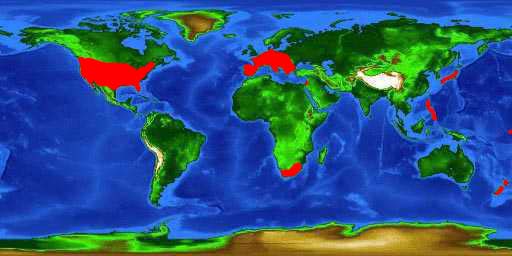
World distribution map for the Black Sea bass
Common Names |
Common names in the English language are largemouth bass, bass, American black bass, bayou bass, bigmouth bass, black bass, bucket mouth, chub, green bass, green trout, lake bass, large-mouth bass, largemouth, largemouth black bass, line side, marsh bass, northern largemouth bass, Oswego bass, slough bass, southern largemouth, trout, and welchman. Other common names include achiga (Portuguese), achigan (French)
|
Geographical Distribution |
This bass is one of the most widely distributed fishes in the world. This is due in large part to the popularity of bass as a sport fish which has lead to the introduction of largemouth bass populations into many areas where they are not native. Their current range includes the U.S., South Africa, Europe, Guam, Japan, Lebanon, New Zealand, and the Philippines.
The original range of the largemouth bass is most of the eastern half of the United States, however it is now found generally in the majority of the United States, including swamps, ponds, lakes, reservoirs, creeks and large rivers.
|
|
The largemouth bass lives in all types of water, including swamps, ponds, lakes, reservoirs, creeks and large rivers. The bass can even be found in estuaries. It prefers weedy oxbows and clears floodplain lakes. Since it is generally a warm water (81-86??F, (27.2??-30??C)) fish, it is seldom found at depths of more than 18.8 feet. During the winter, largemouth bass generally will move into deeper waters. In the spring, largemouth's migrate into bays that have warmed up sooner than that of the main body of water.
During the day, largemouth bass may cruise above aquatic plants at depths of 3.1-9.4 ft, or lie under lily pads or in the shade of overhanging trees, piers, or brush. In the evening hours, largemouth bass tend to move into shallow water to feed. After night falls, they return to deeper water, where they rest on the bottom under logs or trees. In cold temperate climates, largemouth bass generally move into deeper waters during the winter months followed by movement to warmer, shallow waters in the springtime.
|
|